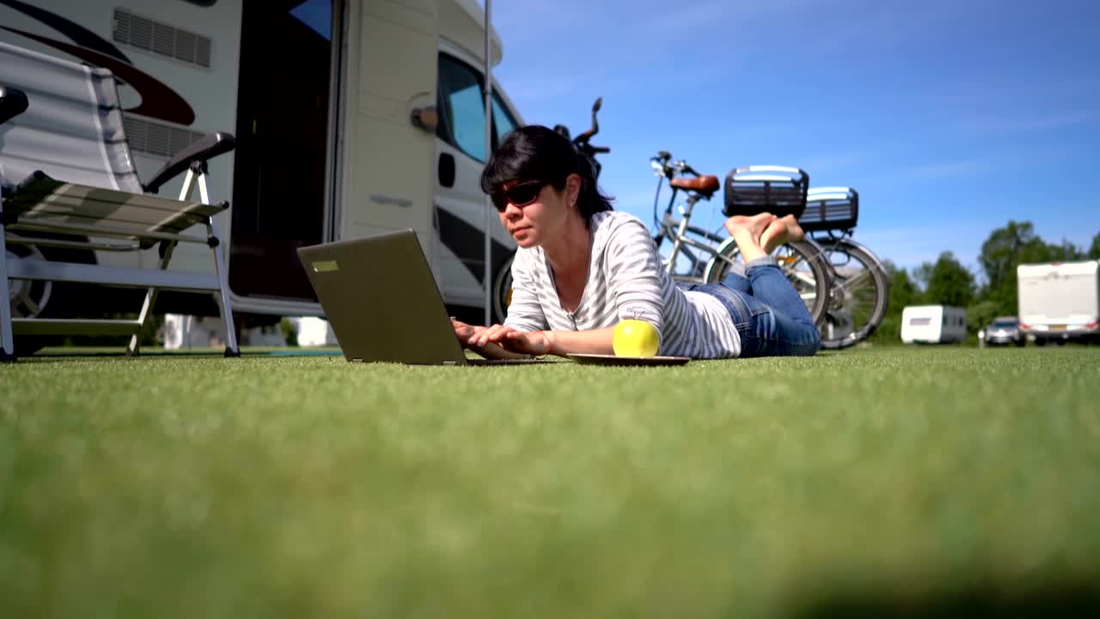
RV Summer Cooling Tips + What to Know About Camper Insurance
Unlike traditional homes, RVs are not designed for extreme climate insulation. They’re lightweight, mobile, and easy to tow, which means the walls, ceiling, and windows don’t hold up well against hours of direct sunlight.
Some RV parks don’t offer shaded spots, and when you’re stuck on an exposed pad in Texas or Florida, the sun turns your RV into a slow cooker by noon.
The result:
- AC units that run nonstop
- Power usage over 1,500 kWh/month
- Interior temps stuck in the low 80s even when both ACs are on
- Energy bills easily exceeding $150–$200/month
So what’s the solution?
Real-World Tips for Keeping Your RV Cooler
Use Reflectix or Bubble Foil Insulation, Strategically
This is one of the best tools you can use. Placing Reflectix (or similar silver foil insulation) in your windows helps reflect heat before it enters your space.
- Start with west-facing windows that get the most sun.
- Add it to skylights, screen doors, and even cabinets that heat up.
- Consider temporary window covers on the outside if park rules allow it.
Yes, it darkens the interior. But many RVers agree it drops the internal temperature dramatically.
Create More Exterior Shade
Blocking the sun before it hits your RV is more effective than trying to cool down after the fact.
- Use your awning consistently
- Add mesh shade cloths or solar tarps to the sides of your rig
- Consider portable shade sails for the rear or opposite side
- Install a temporary carport (check with your RV park or landlord first)
Some folks have even created removable roof panels or custom AC unit “koozies” to prevent the rooftop plastic from absorbing so much heat.
Rooftop Solutions Make a Big Difference
Treating your RV roof with a UV protectant can reduce heat absorption. If you’re feeling ambitious, line the top of your RV with bubble foil insulation, just be sure vents and AC units can still function properly.
This might not look great, but when your interior drops from 85°F to 75°F, aesthetics take a back seat.
Nighttime Cooling Strategy
If you're in a location that cools down at night (Dallas isn’t great for this, but other spots are), lower your thermostat overnight to cool the RV deeply. During the day, let that cooler air linger by minimizing heat gain.
- Set your AC lower at night (74°F or less)
- Keep everything sealed tight during the day
- Use blackout curtains or reflective panels to retain that cool air longer
What About AC Unit Placement?
Some RVers consider adding insulation around their rooftop AC units, especially when parked for long stretches. Just be careful not to block air vents or damage plastic housings.
Using a custom AC cover (or even a DIY “koozie”) for when you're parked can reduce the direct heat beating down on your unit, helping it run more efficiently.
Reduce Power Use Without Sacrificing Comfort
- Avoid using your stove or oven, cook outdoors, use a slow cooker, or eat cold meals
- Run ceiling or box fans to help circulate cold air
- Seal air gaps around windows, vents, and slide-outs with weather stripping
- Upgrade to energy-efficient LED lights to reduce ambient heat indoors
RV Size and Layout Matters
If you're in a large 40+ foot motorhome or fifth wheel with multiple AC units, expect usage around 80–100 kWh per day in Texas-level heat, especially without solar. If you’re running one or two ACs in a smaller unit (like a 25–30 ft camper), 1,500 kWh/month is still realistic in peak summer unless you make adjustments.
Bonus Tip: Know Your RV Insurance Coverage
Running your AC constantly doesn’t just wear down your electric bill, it stresses your equipment. Over time, AC components and electrical systems may fail.
If you're living full-time in your camper, RV camper insurance (or motorhome insurance if you're in a Class A or C) should include:
- Comprehensive coverage for AC unit damage from power surges or weather
- Full-timer liability if you use your RV as a permanent residence
- Personal effects coverage for electronics and furnishings affected by heat or electrical issues
- Emergency expense coverage if you need to relocate during a breakdown
If you’re a seasonal or part-time traveler, a lighter travel trailer insurance policy might be enough. But if you live in your RV year-round, you’ll want RV full-time insurance, it works more like homeowner’s coverage than auto insurance.
Talk to an agent who understands how RVs are used, and confirm what your policy includes. Cheap coverage won’t mean much when your AC fails and takes your fridge with it.
Recap: How to Stay Cool and Save Energy in Your RV
- Use Reflectix or bubble foil insulation in sun-exposed windows
- Add shade cloths, sails, or tarps to block direct sunlight
- Insulate your roof or AC units when parked long-term
- Keep your RV sealed during the day and drop temps at night
- Use external fans, blackout curtains, and smart thermostat strategies
- Cut down on internal heat by cooking less and switching to LED lighting
- Review your RV camper insurance to make sure you’re covered for weather-related wear and AC issues
